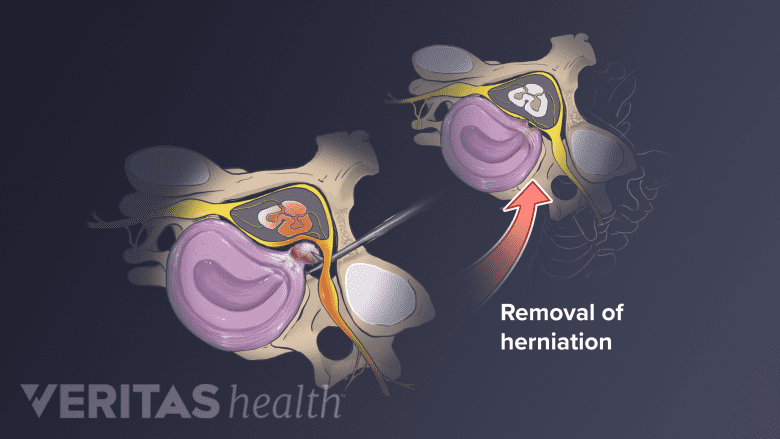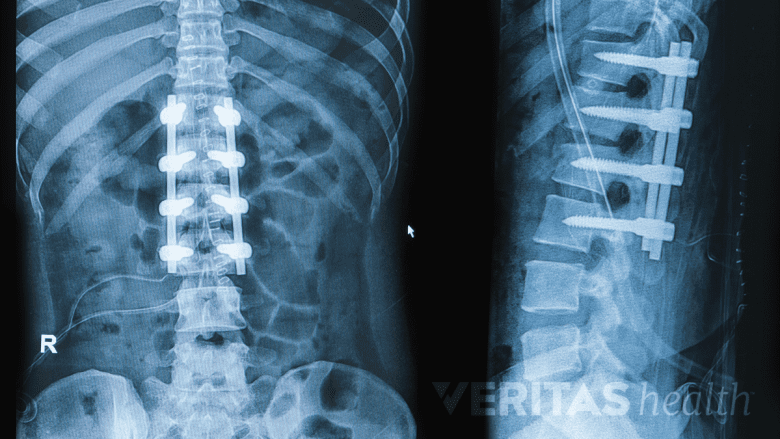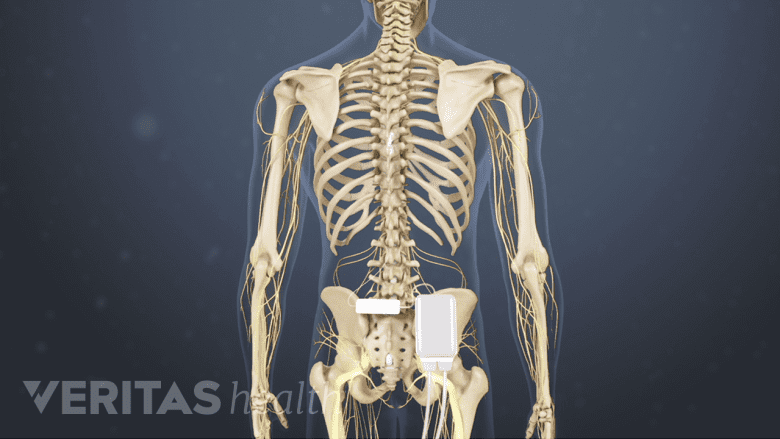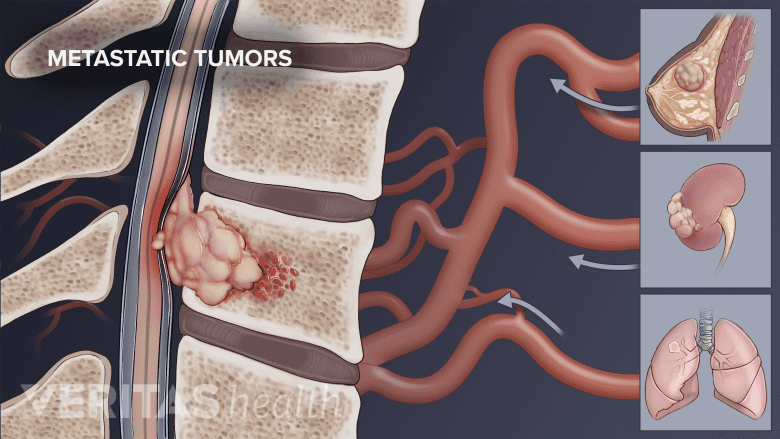There are several types of back surgeries to stabilize the spine and reduce pain.
Surgical treatment does not guarantee 100% symptom relief, but learning about the available options and the pros and cons of each procedure helps patients make informed decisions about their health and treatment.
In This Article:
- Lumbar Spine Surgery
- Types of Lumbar Spine Surgeries: What You Need to Know
- What to Expect from Spine Surgery for Low Back Pain
- Lumbar Spine Surgery Alternatives
Lumbar Decompression: Surgery to Relieve Nerve Compression
Decompression is designed to alleviate pain caused by pinched lumbar spinal nerves. When pinched, these nerves cause pain, numbness, and abnormal sensations in the lower back, buttock, thigh, leg, and/or foot.
In a lumbar decompression surgery, a small portion of the bone over the nerve root or disc material from under the nerve root is removed to give the nerve root more space and provide a better healing environment.
There are 2 types of decompression surgeries:
Lumbar microdiscectomy

Discectomy surgery aims to remove the herniated part of a disc.
A microdiscectomy removes the herniated or bulged portion of a disc in the lower back (lumbar disc) that pinches or compresses a nearby spinal nerve. When the herniated portion of the disc is removed, the nerve:
- Is allowed more space to heal
- Does not cause inflammation and pain
Microdiscectomy is most commonly done to treat sciatica symptoms in the thigh, leg, and foot.
Microdiscectomy can be performed using a traditional approach or endoscopically.
Lumbar laminectomy
Lumbar laminectomy, also called open decompression, is a surgical procedure performed to treat the symptoms of central canal stenosis (narrowing of the spinal canal). The surgery involves the removal of all or part of the lamina (bony structure in the back of the vertebra) to provide more space for the compressed spinal cord and/or nerve roots.
Lumbar laminectomy treats sciatica symptoms as well as more serious medical conditions, such as cauda equina syndrome.,
Microdiscectomy and laminectomy may include smaller procedures such as:
- Facetectomy, where the facet joints are trimmed, undercut, or removed to relieve nerve root pressure
- Foraminotomy, where the opening for the spinal nerve (intervertebral foramen) is enlarged by removing bony overgrowth
Less common decompression surgeries are corpectomy—removal of the body of a vertebra and the discs, and costotransversectomy—removal of a part of a rib along with the transverse process of a vertebra. These surgeries help relieve pressure on the spinal cord from conditions such as spinal tumors and cancers.
Lumbar Spinal Fusion: Surgery to Stabilize the Low Back
Fusion of a motion segment involves creating a bony bridge between two contiguous vertebrae behind the disc, through the disc space, or both. This solid bridge stabilizes the spine and stops any motion at the fused motion segment.
Lumbar spinal fusion surgery is designed to eliminate motion in the painful motion segement and reduce pain.
A fusion surgery is recommeneded for the treatment of:
- Conditions that cause spinal malalignment or spinal degeneration, such as lumbar degenerative disc disease, degenerative spondylolisthesis, and isthmic spondylolisthesis
- Structural changes in the spine, such as scoliosis
A combination of anterior and posterior lumbar fusion surgery may be performed if the front and back of the spine need to be fused.
This type of surgery is typically indicated when a high degree of spinal instability is present (such as in complex spinal fractures or spondylolisthesis), or in a revision surgery if the initial fusion did not set up.
Multilevel Spinal Fusion: Fusing 2 or More Spinal Motion Segments

A multilevel spinal fusion involves fusion 2 or more spinal segments.
Some fusion surgeries may involve fusing 2 or more motion segments of the spine to become one single unit. This type of surgery is called a multilevel spinal fusion.
Multilevel spinal fusion is almost always performed on contiguous spinal levels.
Interspinous Spacer: Preserving Posterior Spinal Motion

An interspinous spacer helps restore the height between adjacent vertebrae.
Posterior motion preservation spine surgery involves the implantation of small, specialized devices to open up bony spaces in the spine and decompress pinched spinal nerves. The commonly used device is an interspinous spacer, which is designed to open up the foramen—the bony opening through which the nerve endings pass out of the spinal cord and into the legs. Interspinous spacers are used to relieve nerve compression from spinal degeneration and lumbar degenerative disc disease.
The interspinous device implantation surgery can be performed under mild sedation and local anesthesia as an outpatient/day surgery procedure and the patient can go home the same day. In select patients, the implantation of this device may serve as an alternative to a more complex spinal fusion surgery.
Facet Arthroplasty: Arthritic Facet Joint Replacement in the Spine
Total facet arthroplasty (TFA) is an implant intended to replace painful and stiff arthritic facet joints. This surgery may be combined with a spinal decompression surgery and aims to restore function and improve spinal stability.
The joint implant is inserted through an open surgical approach. The implant is fixed into the vertebral pedicles using bone cement. TFA surgery is new, and the long-term results of this surgery are not established in the literature.
Spinal Cord Stimulation (SCS): Reducing Pain Through Electric Stimulation

SCS delivers mild electrical pulses to the nerves in the spinal cord.
Spinal cord stimulation, also called neurostimulation, is a treatment where mild electrical pulses are directed to the nerves in the spinal cord. These impulses interfere with pain signals, stopping them from reaching the brain.
Spinal cord stimulation surgery includes the implantation of a small device (similar to a cardiac pacemaker) near the spine, which generates these pulses. One benefit of this procedure is that it is tried for a short time before a person commits to having the surgical implant.
Separation Surgery: Separating Spinal Tumors from the Spinal Cord

Metastatic tumors spread to the spine from other parts of the body.
Metastatic spinal tumors (tumors that spread to the spine from cancer elsewhere in the body) pressing on the spinal cord may be treated with a special surgical technique called separation surgery. The goal of this surgery is to remove enough of the tumor to separate it from the spinal cord to achieve spinal cord decompression. After the tumor is separated and removed, radiation therapy can be performed on the remaining part of the tumor with less risk to the spinal cord.
When indicated, a combination of separation surgery and radiation therapy enables more of the vertebra to remain intact compared to more traditional spinal decompression surgeries.
Vertebroplasty and Kyphoplasty: Surgery to Treat Vertebral Fractures

During vertebroplasty, bone cement is injected into the weakened portions of the bone.
Vertebroplasty and kyphoplasty, are most commonly used in cases of severe, functionally disabling pain caused by a vertebral fracture that does not improve over a number of weeks with pain medication and lumbar bracing.
Both procedures involve the placement of cement into the fractured vertebra through small, minimally invasive incisions in the skin under X-ray guidance using fluoroscopy.
Robot-Assisted Lumbar Surgery: A Modern Advancement to Spine Surgery

A robot-assisted surgery is guided by a surgeon.
With less invasive and higher precision abilities, robot-assisted spine surgeries have emerged as a modern advancement in the surgical field. The several advantages of robot-assisted surgeries over manual surgical methods are:
- They provide real-time intraoperative navigation
- Potentially lower radiation exposure
- Potentially lower complication rates
- Potentially lower surgical time
- Faster recovery in some cases
Spinal fusion surgeries and surgeries requiring the placement of spine fusion instrumentation may be performed through robotic assistance.

